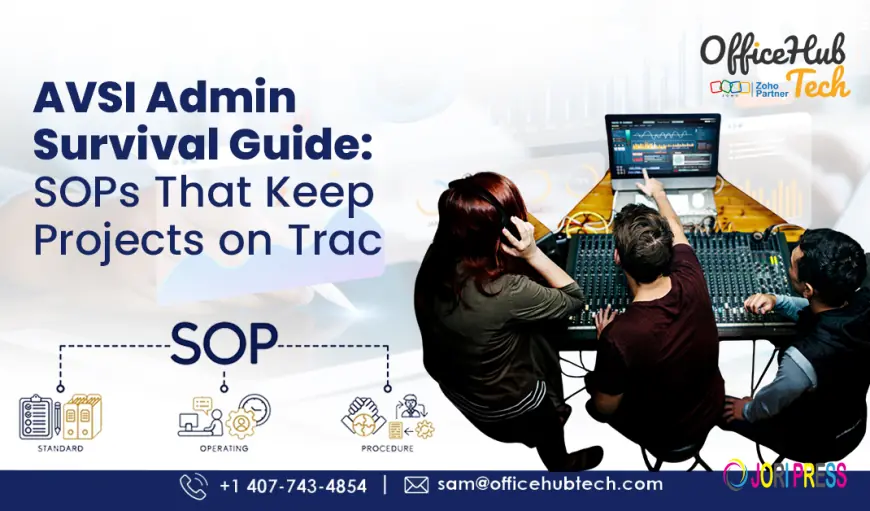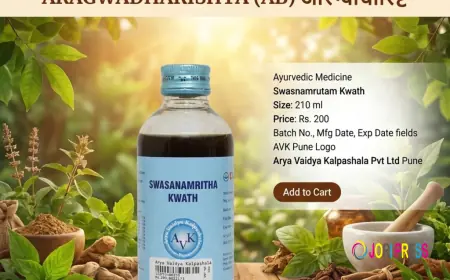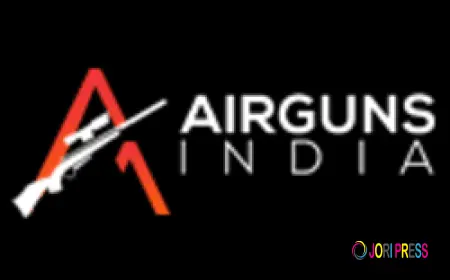AVSI Admin Survival Guide: SOPs That Keep Projects on Track
Keep AVSI projects on track with essential SOPs, smart workflows, and automation tools for efficient project management and consistent results.

Have you ever wondered why certain AVSI projects are delivered flawlessly, while others struggle with delays and budget overruns? What’s the secret to ensuring every installation, upgrade, or maintenance task is completed accurately and on schedule? The answer lies in establishing well-defined Standard Operating Procedures (SOPs).
SOPs serve as detailed, step-by-step guidelines for every stage of a project. They keep teams organized, minimize errors, and ensure both timelines and costs are maintained. By leveraging Zoho for AVSI automation, administrators can further streamline repetitive processes and track project progress in real time.
If you’re ready to gain full control over your AVSI operations, this guide outlines the key SOPs every administrator should adopt—along with a roadmap for implementing them effectively.
Essential SOPs Every AVSI Administrator Should Implement
SOPs are the backbone of efficiency, quality, and consistency within any AVSI organization. These procedures serve as actionable roadmaps that help complete installations, services, and upgrades on time and within budget. Below are the most crucial SOPs every AVSI admin should put into practice to ensure project success and client satisfaction.
1. Project Kickoff and Scope Validation
This SOP guarantees that each project begins with complete clarity. It defines the client’s needs, technical details, and on-site conditions before installation starts. It involves conducting site surveys, validating design drawings, and obtaining client approvals. When managed through Zoho Projects or Zoho Creator, this structured kickoff process ensures all stakeholders are aligned and communication is seamless from day one.
2. Design Review and Change Control
Design modifications are common in AV projects, but without an approval framework, they can cause confusion and overspending. This SOP outlines how proposed changes should be reviewed, approved, and documented. By automating this process through Zoho workflows, project teams can ensure transparency, minimize risks, and maintain accurate technical and financial records.
3. Procurement and Inventory Management
This SOP covers how equipment and materials are purchased, received, and stored. It sets standards for vendor evaluation, quotation comparison, and order tracking. Integrating this SOP with Zoho Books or Zoho Inventory provides real-time visibility of stock levels, purchase orders, and delivery timelines—reducing delays and preventing both shortages and excess inventory.
4. Logistics and Installation Planning
Proper logistics are essential for smooth on-site operations. This SOP includes scheduling technicians, organizing tools, assessing safety requirements, and managing site access. With Zoho Projects, teams can coordinate the right personnel and materials at the right time, reducing idle hours and keeping installation activities on track.
5. Installation and Commissioning
This SOP guides technicians through systematic setup and testing procedures. It details every step—mounting, wiring, calibrating, and verifying performance—to ensure compliance with design and quality standards. Using Zoho mobile apps, teams can document progress instantly with photos and reports, improving accountability and ensuring each system is fully functional before handover.
6. Quality Assurance and Handover
To guarantee client satisfaction, this SOP ensures that projects meet all performance standards prior to delivery. It involves demonstrations, collecting client sign-offs, and compiling documentation like as-built drawings and manuals. Using Zoho WorkDrive or Zoho Sign simplifies document management and digital approvals, promoting professionalism and smooth project closure.
7. Warranty, Service, and Maintenance
This SOP governs post-installation activities such as service requests, issue tracking, and preventive maintenance. Integrated with Zoho Desk or Zoho Creator, it automates ticket assignments, reminders, and responses—helping AVSI firms maintain customer trust and manage warranty commitments efficiently.
8. Change, Upgrade, and Expansion Management
Clients often request system enhancements or modifications after project completion. This SOP ensures such requests are assessed, estimated, approved, and tracked systematically through Zoho CRM or Zoho Projects. It enhances traceability, cost control, and transparency in client communication.
9. Documentation and Knowledge Management
Effective documentation prevents data loss and ensures operational continuity. This SOP defines how all technical files, manuals, and configurations are versioned and stored. With a centralized system like Zoho WorkDrive, teams can access critical information easily, reducing dependence on individual employees and ensuring smooth service operations.
10. Project Closure and Lessons Learned
This SOP provides a structured approach to concluding projects—covering cost reconciliation, client feedback, and performance review. By capturing insights in Zoho Analytics or Zoho Creator, AVSI teams can identify areas for improvement and foster a culture of continuous learning.
How AVSI Firms Can Effectively Deploy SOPs
Implementing SOPs successfully is vital for enhancing productivity, eliminating inefficiencies, and achieving on-time project delivery. Here’s a structured approach to put them into action:
1. Assess Current Practices and Tools
Begin by analyzing existing project management and operational workflows. Identify bottlenecks and repetitive manual tasks. Evaluate current tools and determine how Zoho applications can automate these processes, setting a baseline for SOP implementation.
2. Design SOPs and Workflow Mapping
Develop detailed SOPs for each core process, clearly defining roles, timelines, and performance indicators. Map these SOPs with Zoho workflows to enable automation and consistency, ensuring teams stay synchronized and projects remain reliable.
3. Pilot SOPs on Selected Projects
Test the new SOPs on a few projects to assess practicality and gather feedback. Real-time dashboards in Zoho help monitor results and address issues quickly, ensuring smooth execution before full-scale rollout.
4. Full Rollout and Training
Once validated, deploy SOPs organization-wide. Provide hands-on training sessions for all team members, along with guides and tutorials. This ensures everyone follows procedures consistently and maintains high-quality standards.
5. Governance and Continuous Improvement
Assign SOP owners, review them regularly, and track key metrics using Zoho Analytics. Update processes based on project insights to encourage continual improvement and adaptability.
Conclusion
Having well-structured SOPs is no longer optional—it’s essential for completing AVSI projects on time, within budget, and with consistent quality. When combined with Zoho’s automation and monitoring tools, these procedures become dynamic workflows that guide every phase—from planning to handover—with precision.
OfficeHubTech plays a pivotal role in this transformation by offering customized Zoho solutions specifically designed for AVSI operations. Their expertise helps organizations convert SOPs into digital workflows, eliminate manual inefficiencies, and monitor project progress seamlessly. As project demands grow more complex, the integration of well-defined SOPs with smart technology ensures that every task is executed efficiently, every deadline is achieved, and every system performs flawlessly.
What's Your Reaction?
 Like
0
Like
0
 Dislike
0
Dislike
0
 Love
0
Love
0
 Funny
0
Funny
0
 Angry
0
Angry
0
 Sad
0
Sad
0
 Wow
0
Wow
0
















































